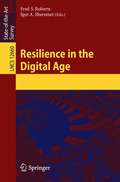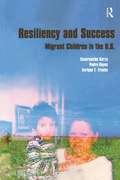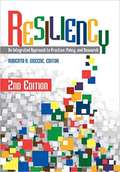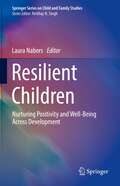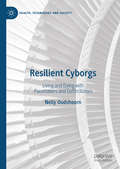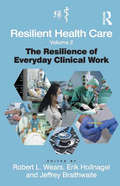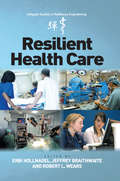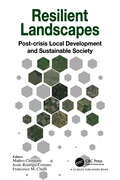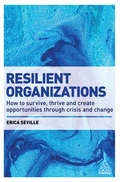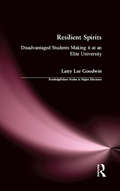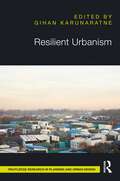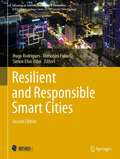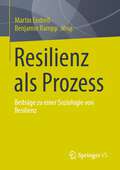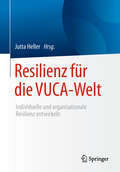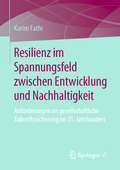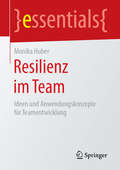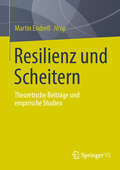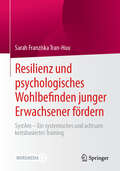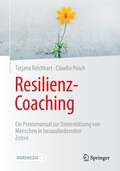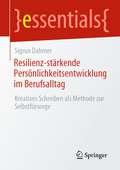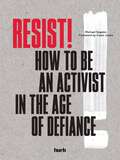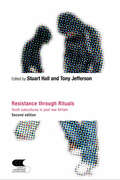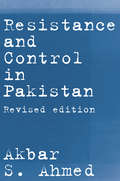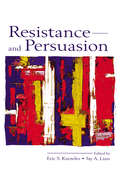- Table View
- List View
Resilience in the Digital Age (Lecture Notes in Computer Science #12660)
by Fred S. Roberts Igor A. SheremetThe growth of a global digital economy has enabled rapid communication, instantaneous movement of funds, and availability of vast amounts of information. With this come challenges such as the vulnerability of digitalized sociotechnological systems (STSs) to destructive events (earthquakes, disease events, terrorist attacks). Similar issues arise for disruptions to complex linked natural and social systems (from changing climates, evolving urban environments, etc.). This book explores new approaches to the resilience of sociotechnological and natural-social systems in a digital world of big data, extraordinary computing capacity, and rapidly developing methods of Artificial Intelligence. Most of the book’s papers were presented at the Workshop on Big Data and Systems Analysis held at the International Institute for Applied Systems Analysis in Laxenburg, Austria in February, 2020. Their authors are associated with the Task Group “Advanced mathematical tools for data-driven applied systems analysis” created and sponsored by CODATA in November, 2018. The world-wide COVID-19 pandemic illustrates the vulnerability of our healthcare systems, supply chains, and social infrastructure, and confronts our notions of what makes a system resilient. We have found that use of AI tools can lead to problems when unexpected events occur. On the other hand, the vast amounts of data available from sensors, satellite images, social media, etc. can also be used to make modern systems more resilient. Papers in the book explore disruptions of complex networks and algorithms that minimize departure from a previous state after a disruption; introduce a multigrammatical framework for the technological and resource bases of today’s large-scale industrial systems and the transformations resulting from disruptive events; and explain how robotics can enhance pre-emptive measures or post-disaster responses to increase resiliency. Other papers explore current directions in data processing and handling and principles of FAIRness in data; how the availability of large amounts of data can aid in the development of resilient STSs and challenges to overcome in doing so. The book also addresses interactions between humans and built environments, focusing on how AI can inform today’s smart and connected buildings and make them resilient, and how AI tools can increase resilience to misinformation and its dissemination.
Resiliency and Success: Migrant Children in the U.S.
by Encarnacion Garza Enrique T. Trueba Pedro ReyesThis book elucidates the amazing life journeys of academically successful migrant students. Offering vivid case studies of successful students, this book helps teachers, education students, and researchers understand the factors that lead to success by minority language children. The authors develop the lessons of student success stories into recommendations for schools and for educational policy. Readers gain from this book the stories of real students, the challenges they faced, and the means by which students and schools may overcome language and cultural barriers to educational success.
Resiliency: An Integrated Approach to Practice, Policy, and Research
by Roberta R. GreeneAfter a decade of informing students and practitioners in the field, Resiliency: An Integrated Approach to Practice, Policy, and Research, 2nd edition, updates Roberta R. Greene's seminal text on resiliency theory for a new decade. Emerging from the ecological and systems frameworks of the profession's person-in-environment approach, resiliency theory offers social workers a perspective that is empirically based, practical, and focused on personal strengths. <p><p> Illustrated with clear examples of resiliency-based practice in a variety of settings and drawing on numerous social work approaches, Resiliency equips readers with specific intervention strategies to nurture and supports clients' strengths, self-efficacy, and ability to adapt to changing circumstances, and heal.
Resilient Children: Nurturing Positivity and Well-Being Across Development (Springer Series on Child and Family Studies)
by Laura NaborsThis book examines resilience in childhood, focusing on positive functioning and development, often in the face of everyday difficulties and adversities. It highlights critical areas in which children and their families can demonstrate resilience and attain positive social, emotional, academic, and behavioral life trajectories. The book describes key factors related to enhancing resilience for children, such as positive relationships with adults, positive school environments, and meaningful connections with others. It provides practical guidelines for promoting resilience in youth and reviews the critical nature of resilience across various situations, critical issues, and different developmental periods. It offers guidance on strategies for fostering resilience in children.Key topics featured include:Raising children to have grit and tenacity.Fostering resilience in children at school and within their families.Nurturing resilience in children with chronic illnesses and posttrauma.Resilient Children is an essential resource for researchers, professors, and graduate students as well as clinicians, therapists, and other professionals in developmental, clinical, and school psychology, family studies, public health, and social work as well as all related disciplines, including educational psychology, child and adolescent psychiatry, and pediatrics.
Resilient Cyborgs: Living and Dying with Pacemakers and Defibrillators (Health, Technology and Society)
by Nelly OudshoornThis book examines how pacemakers and defibrillators participate in transforming life and death in high-tech societies. In both popular and medical accounts, these internal devices are often portrayed as almost magical technologies. Once implanted in bodies, they do not require any ‘user’ agency. In this unique and timely book, Nelly Oudshoorn argues that any discourse or policy assuming a passive role for people living with these implants silences the fact that keeping cyborg bodies alive involves their active engagement. Pacemakers and defibrillators not only act as potentially life-saving technologies, but simultaneously transform the fragility of bodies by introducing new vulnerabilities. Oudshoorn offers a fascinating examination of what it takes to become a resilient cyborg, and in the process develops a valuable new sociology of creating ‘resilient’ cyborgs.
Resilient Health Care, Volume 2: The Resilience of Everyday Clinical Work (Ashgate Studies in Resilience Engineering)
by Robert L. Wears Erik HollnagelHealth systems everywhere are expected to meet increasing public and political demands for accessible, high-quality care. Policy-makers, managers, and clinicians use their best efforts to improve efficiency, safety, quality, and economic viability. One solution has been to mimic approaches that have been shown to work in other domains, such as quality management, lean production, and high reliability. In the enthusiasm for such solutions, scant attention has been paid to the fact that health care as a multifaceted system differs significantly from most traditional industries. Solutions based on linear thinking in engineered systems do not work well in complicated, multi-stakeholder non-engineered systems, of which health care is a leading example. A prerequisite for improving health care and making it more resilient is that the nature of everyday clinical work be well understood. Yet the focus of the majority of policy or management solutions, as well as that of accreditation and regulation, is work as it ought to be (also known as ’work-as-imagined’). The aim of policy-makers and managers, whether the priority is safety, quality, or efficiency, is therefore to make everyday clinical work - or work-as-done - comply with work-as-imagined. This fails to recognise that this normative conception of work is often oversimplified, incomplete, and outdated. There is therefore an urgent need to better understand everyday clinical work as it is done. Despite the common focus on deviations and failures, it is undeniable that clinical work goes right far more often than it goes wrong, and that we only can make it better if we understand how this happens. This second volume of Resilient Health Care continues the line of thinking of the first book, but takes it further through a range of chapters from leading international thinkers on resilience and health care. Where the first book provided the rationale and basic concepts of RHC, the Resilience of Everyday Clinical Work b
Resilient Health Care: The Resilience Of Everyday Clinical Work (Ashgate Studies in Resilience Engineering)
by Jeffrey Braithwaite Erik HollnagelHealth care is everywhere under tremendous pressure with regard to efficiency, safety, and economic viability - to say nothing of having to meet various political agendas - and has responded by eagerly adopting techniques that have been useful in other industries, such as quality management, lean production, and high reliability. This has on the whole been met with limited success because health care as a non-trivial and multifaceted system differs significantly from most traditional industries. In order to allow health care systems to perform as expected and required, it is necessary to have concepts and methods that are able to cope with this complexity. Resilience engineering provides that capacity because its focus is on a system’s overall ability to sustain required operations under both expected and unexpected conditions rather than on individual features or qualities. Resilience engineering’s unique approach emphasises the usefulness of performance variability, and that successes and failures have the same aetiology. This book contains contributions from acknowledged international experts in health care, organisational studies and patient safety, as well as resilience engineering. Whereas current safety approaches primarily aim to reduce or eliminate the number of things that go wrong, Resilient Health Care aims to increase and improve the number of things that go right. Just as the WHO argues that health is more than the absence of illness, so does Resilient Health Care argue that safety is more than the absence of risk and accidents. This can be achieved by making use of the concrete experiences of resilience engineering, both conceptually (ways of thinking) and practically (ways of acting).
Resilient Landscapes: Post-crisis Local Development and Sustainable Society
by Jesús Rodrigo-Comino Matteo Clemente Francesco M. ChelliIn recent years, resilient districts have become territorial contexts for projects designed to respond to the needs of local communities, through the exploitation of landscape peculiarities to overcome the economic crisis. This volume offers a comprehensive insight on sustainable development of local territories. It recommends the planning of local interventions through the integration of sustainable development with resilience of local systems. The chapters originate from either individual or collective work independently conducted, but at the same time integrated by scholars from different academic backgrounds, among which environmental and agrarian sciences, social and economic disciplines, and urban planning and landscape design are included.
Resilient Organizations
by Pirotti Guia Beatrice Markus VenzinRecent financial crises have shown that firms need to create more robust business models. However, it seems that the task of developing resilience - a firm's ability to adapt, endure, bounce back and then thrive, despite the shock - appears on most managers' strategic issue list only after such a shock has occurred. Managers, through responsible leadership, can make explicit choices that will enhance their firm's resilience, increasing their chances of anticipating and avoiding these shocks. This book is the result of a three-year research project across seven industries, and is aimed at improving the understanding of why some firms are better than others in dealing with market turbulence. Pirotti and Venzin develop a measure for organizational resilience, identifying resilience drivers and demonstrating how firms can appropriate value from high resilience levels. It is a valuable read for graduates taking a course in strategy and global management and for reflective practitioners.
Resilient Organizations: How to Survive, Thrive and Create Opportunities Through Crisis and Change
by Erica SevilleSome organizations are able to survive and thrive through times of uncertainty while others stumble and fall at the first sign of trouble. What differentiates resilient organizations from those that are not? Do we need to wait until a crisis strikes to see how resilient an organization is, or can we diagnose resilience in advance of a crisis? Resilient Organizations draws on primary research to reveal the answers to these questions and provide practical ideas and actions to make your own organization more resilient. Organizational resilience is not just about minimizing and managing risk exposure; it is about creating organizations with the agility to adapt to unexpected challenges and the capacity to seize opportunity out of adversity. Dr Erica Seville, founder of the Resilient Organizations research programme, provides readers with the essential knowledge required to enable organizations to thrive in a world of change and uncertainty, where resilience is an increasingly important strategic capacity. Drawing on a decade of research, her team have identified 13 indicators to diagnose an organization's resilience. Resilient Organizations draws out the top five ingredients and shows how organization resilience is a capability that can and must be proactively fostered and maintained over time. Using case studies, diagnostic tools and key actions and initiatives to develop and maintain organizational resilience, Resilient Organizations is essential reading for everyone tasked with developing strong organizations that can survive and thrive in crisis and change - from risk, resilience and business continuity professionals to leadership and management teams.
Resilient Spirits: Disadvantaged Students Making it at an Elite University (RoutledgeFalmer Studies in Higher Education)
by Latty Lee GoodwinThis study explores the identity construction of socioeconomically and educationally disadvantaged students who enter an elite university. This critical ethnography gathered qualitative data about the twenty-three participants through non-participant observation, in-depth interviews, and focus groups. Faculty, staff, and administrators were also interviewed.
Resilient Urbanism (Routledge Research in Planning and Urban Design)
by Gihan KarunaratneAs urban populations grow unprecedentedly, cities worldwide face pressures from rapid expansion, climate change, and social inequalities. Resilient Urbanism critically examines how cities, towns, and informal settlements adapt to these multifaceted challenges, exploring urban resilience in the 21st century.This volume investigates resilience across a variety of urban contexts, from megacities in the Global South to suburban and coastal regions, through interdisciplinary essays. The contributors examine how urban communities confront crises, navigate urbanization, adapt to climate change, and respond to socioeconomic transformations using innovative and, at times, unconventional strategies. Case studies highlight the lived experiences of urban dwellers, from informal settlements in Maputo, Rio de Janeiro, and Hanoi to the challenges of achieving energy efficiency in Buenos Aires.By interrogating dominant discourses on urban resilience, Resilient Urbanism offers a reimagined perspective on how cities and their inhabitants address uncertainty and change. It emphasizes the everyday practices of urban residents and explores the sociopolitical dynamics of urbanization, presenting resilience not merely as a theoretical framework but as a lived, evolving process. This work sheds light on how cities withstand crises and actively reshape themselves in response to these disruptions.This volume is an essential resource for scholars, urban planners, policymakers, and professionals concerned with the future of cities. It underscores that urban resilience is not just a theoretical concept but a vital imperative for navigating the complexities of a rapidly changing global landscape.
Resilient and Responsible Smart Cities (Advances in Science, Technology & Innovation)
by Simon Elias Bibri Hugo Rodrigues Tomohiro FukudaThis book gathers current research studies which explore new technologies in architecture and urban practices which ensure the efficient management of cities’ infrastructures and provide new solutions to the complex complications that may result in the tackling of challenges of population density, traffic planning, and city planning at the neighborhood scale or rather the scale of buildings and everyday life. It offers a path towards city resilience and sustainable infrastructure with the aim of meeting the demands of mega-cities. The primary audience of this book will be academics and professionals from the fields of architecture, urban planning, civil engineering, computer sciences, and mathematics. The book will aid them in their contributions to the implementation of sustainable development goals.
Resilienz als Prozess: Beiträge zu einer Soziologie von Resilienz
by Martin Endreß Benjamin RamppDas Konzept „Resilienz“ erfährt seit einigen Jahren in der Soziologie eine bemerkenswerte Resonanz. Es scheint für die Sozialwissenschaften allgemein und die Soziologie im Besonderen eine interessante und vielversprechende neue Zugangsweise zu zentralen gesellschaftlichen Themen und Handlungsfeldern zu bieten. Die Beiträge des Bandes loten die Transformationserfordernisse für eine Übertragung des Resilienzansatzes aus und konturieren exemplarisch die sich daraus ergebenden Potentiale für die soziologische und sozio-historische Forschung in theoretisch-konzeptionellen Beiträgen und im Rahmen von empirischen Fallstudien. Das übergeordnete Analyseinteresse liegt dabei auf nichtlinearen sozio-historischen Mehrebenenprozessen, die durch eine enge Verknüpfung von Phänomenen der Kontinuität und der Diskontinuität charakterisiert sind.
Resilienz für die VUCA-Welt: Individuelle und organisationale Resilienz entwickeln
by Jutta HellerVUCA (volatility, uncertainty, complexity, ambiguity) bestimmt unsere Umwelt, im privaten wie im Unternehmenskontext. Krisen stehen auf der Tagesordnung, so dass Krisenantizipation,Anpassung, Regeneration von und Lernen aus der Krise immer wichtiger für eine erfolgreiche Lebens- und Arbeitsgestaltung werden. Diese Krisenkompetenz heißt Resilienz. Coachs, Führungskräfte und UnternehmerInnen erhalten in diesem Sammelband einen umfassenden Überblick über die Herangehensweisen an Resilienz. Denn Resilienz ist einerseits die Fähigkeit, flexibel mit Krisen und Dauerbelastung umzugehen. Andererseits ermöglicht Resilienz aber auch, sensibel auf Warnzeichen für künftige Krisen zu reagieren sowie nach der Krise schneller wieder handlungsfähig zu werden. Resilienz ist für Individuen und Organisationen gleichermaßen eine wichtige Fähigkeit geworden.
Resilienz im Spannungsfeld zwischen Entwicklung und Nachhaltigkeit: Anforderungen an gesellschaftliche Zukunftssicherung im 21. Jahrhundert
by Karim FathiDas Buch, bewusst in allgemeinverständlicher Sprache für alle interessierten Leserinnen und Leser geschrieben, zeichnet ein einmaliges, transdisziplinäres Gesamtbild von Resilienz als nationalem und internationalem Gesellschaftsfaktor unserer Zeit. Es zeigt, dass der Resilienzbegriff an gesellschaftspolitischer Bedeutung den älteren, bislang dominierenden Konzepten der Nachhaltigkeit und Entwicklung in nichts nachsteht, ja diese aktiv ergänzt, teilweise widerspricht, aber auch vervollständigt. Resilienz als Gesellschaftsfaktor bezieht alle Sektoren, wie z. B. die Politik, Wirtschaft, Wissenschaft und Zivilgesellschaft, mit ein und stellt damit einen unverzichtbaren Referenzrahmen in der übergeordneten neueren Debatte um die „lernende Gesellschaft“ dar.„Fathi analysiert das noch wenig erschlossene Thema der "gesellschaftlichen Resilienz" aus völlig neuen Perspektiven und in einer anregenden thematischen Breite. Ein Muss für jeden, der dieses Thema ganzheitlich erfassen will.“ Prof. Dr. Uwe Schneidewind
Resilienz im Team: Ideen und Anwendungskonzepte für Teamentwicklung (essentials)
by Monika HuberDieses essential gibt Einblicke in Ansätze, Vorgehensweisen und Ideen, wie sich Resilienz, verstanden als Widerstandskraft, im Team fördern und umsetzen lässt. Meist werden diese Konzepte nur auf Einzelpersonen angewendet. Doch viele der Erkenntnisse aus der Resilienzforschung lassen sich auf Teams übertragen und sogar erweitern. So spielt Resilienz heute auch in Teams eine immer größere Rolle: Sei es, um das Kohärenzgefühl nach Antonovskys Prinzip der Salutogenese zu stärken, oder um andere Resilienzfaktoren in Betracht zu ziehen, die die Teamfähigkeit unterstützen.
Resilienz und Scheitern: Theoretische Beiträge und empirische Studien
by Martin EndreßWill man über Resilienz sprechen, darf man über Scheitern nicht schweigen. Das gilt gerade dann, wenn mit einem reflexiven Resilienzbegriff der prozessuale Zuschnitt dieser Beobachtungsperspektive für die Deutung sozio-historischen Geschehens stark gemacht werden soll. Solchermaßen kommen nicht nur Konstellationen eines produktiven Scheiterns in den Blick, sondern ebenso die komplexe Mehrebenenstruktur von Resilienzprozessen, die das Scheitern auf einer mit dem Gelingen auf anderen Ebenen sozialer Prozesse zusammendenken lassen. Zum Themenfeld "Resilienz und Scheitern" versammelt der Band historische und sozialwissenschaftliche Beiträge, die das ambivalente Verhältnis von Resilienzprozessen und Diagnosen des Scheiterns in theoretisch-konzeptioneller Hinsicht ausloten und in ausgewählten historischen Fallstudien vom 13. bis ins 20. Jahrhundert hinein empirisch veranschaulichen. Die Beiträge schreiben damit die Bemühungen der Trierer Forschungsgruppe "Resilienz - Gesellschaftliche Umbruchphasen im Dialog zwischen Mediävistik und Soziologie" fort, ein kritisch reflektiertes Resilienzkonzept für historische und sozialwissenschaftliche Analysen fruchtbar zu machen.
Resilienz und psychologisches Wohlbefinden junger Erwachsener fördern: SystAm - Ein systemisches und achtsamkeitsbasiertes Training
by Sarah Franziska Tran-HuuDas Buch ist ein Trainingsmanual für Praktiker*innen inkl. konzeptionellem Hintergrund, Kursinhalte und aller Praxismaterialien. Das Trainingsmanual soll die Anwendung in unterschiedlichen Kontexten unterstützen, und insbesondere die Lücke von systemisch-orientierten Interventionsprogrammen auf dem derzeitigen Markt schließen. Es greift auf achtsamkeitsbasierte Techniken zurück, die durch gezielte system-therapeutische Übungen ergänzt und erweitert werden. Das Gruppenprogramm ist stark selbsterfahrungsorientiert, nutzt aktivierende, visualisierende und kreative Techniken und Übungen, die durch psychoedukative Inputs und theoretische Anleitungen sowie durch den Austausch in der Gruppe ergänzt werden.
Resilienz-Coaching: Ein Praxismanual zur Unterstützung von Menschen in herausfordernden Zeiten
by Tatjana Reichhart Claudia PuschIn diesem Buch vermitteln Ihnen die Fachärztin für Psychiatrie und Verhaltenstherapeutin Dr. Tatjana Reichhart und die systemische Beraterin, Therapeutin und Lehrtrainerin Claudia Pusch, wie Sie Menschen konkret und praktisch dabei unterstützen können, ihre seelische Widerstandsfähigkeit auszubauen und zu stärken. Die Zielgruppen sind Coaches, Therapeuten, Führungskräfte, Sozialpädagogen, Yoga-Lehrer und alle jene, die mit Menschen arbeiten. Dabei räumen die Autorinnen mit Irrtümern über das Konzept der Resilienz auf, bleiben stets wissenschaftlich fundiert und gleichzeitig leicht verständlich sowie praktisch orientiert. Das Besondere an ihrem Ansatz ist die Zusammenführung ihrer beider unterschiedlichen praktischen Erfahrungshorizonte und Hintergründe. Dieses Buch bringt somit unterschiedliche Techniken und Erkenntnisse aus anerkannten psychologischen Ansätzen zusammen und stellt sie als alltagstaugliches Praxismanual erstmalig in den Kontext des Resilienz-Coachings. Sie als Leser erhalten so einen umfangreichen Wissen- und Methodenschatz, der durchgängig auf der aktuellen Forschungs- und Erkenntnislage über Resilienz und deren Förderung basiert. In der von den beiden Autorinnen geründeten Kitchen2Soul Akademie wird die Ausbildung zum Resilienz-Coach angeboten.
Resilienz-stärkende Persönlichkeitsentwicklung im Berufsalltag: Kreatives Schreiben als Methode zur Selbstfürsorge (essentials)
by Sigrun DahmerDie Anforderungen im Berufsalltag werden immer belastender. Das kreative Schreiben ist ein einfaches und gleichzeitig effizientes Mittel, um Stress abzubauen und Selbstwirksamkeit zu erfahren. Die spielerischen Übungen machen nicht nur Spaß und fördern das kreative Potential, sondern sie dienen auch als Mittel der Selbstreflexion und unterstützen den Aufbau von psychischen Selbstfürsorgestrategien im (Berufs-) Leben. Insgesamt hilft uns das kreative Schreiben dabei, Resilienz aufzubauen, indem wir starke Gefühle abkühlen, schwierige Ereignisse ordnen und eingefahrene Denkwege verlassen.
Resist!: How to Be an Activist in the Age of Defiance
by HuckResist! is the indispensable how-to guide for people looking to make a stand. Included are solid pieces of advice, practical tips and inspirational stories from those who have already successfully stood up and made a difference. Learn the principles of direct action, discover strategies for tackling social media, unearth ideas for motivating others, and understand how to get access to the people in power and get your message across.With a foreword by columnist, campaigner and best-selling author Owen Jones which unravels the political world and underlines why now is the time to act.
Resistance Through Rituals: Youth Subcultures in Post-War Britain (Cultural Studies Birmingham)
by Stuart Hall Tony JeffersonThis revised and expanded edition of Resistance through Rituals includes a new introduction to bring the reader fully up-to-date with the changes that have happened since the work’s first release in the double issue of Working Papers in Cultural Studies in 1975. The work of the Centre for Contemporary Cultural Studies at Birmingham has been noted as historically leading the field in new areas of enquiry within the field of cultural studies, and the papers from the Centre are canonical reading for many cultural studies students. This revised edition includes all the original, exceptional papers, and enhances these with the reflections of the editors thirty years after the original publication. At a time when youth culture had been widely publicised, but few people understood its significance as one of the most striking and visible manifestations of social and political change, these papers redressed the balance. Looking in detail at the wide range of post-war youth subcultures, from teds, mods and skinheads to black Rastafarians, Resistance through Rituals considers how youth culture reflects and reacts to cultural change. This text represents the collective understanding of the leading centre for contemporary culture, and serves to situate some of the most important cultural work of the twentieth century in the new millennium.
Resistance and Control in Pakistan
by Akbar S. AhmedHow can people in the West make sense of contemporary unrest in the Muslim world? Is Islamic fundamentalism to be understood purely in religious terms?In Resistance and Control in Pakistan, one of the world's leading authorities on Islam, Akbar S. Ahmed, illuminates what is happening in the Muslim world today and assesses the underlying causes. He does this by telling the dramatic story of the revolt of the Mullah of Waziristan in northwest Pakistan and by placing it within the context of other movements occurring elsewhere in the Islamic world. He also examines the social structure and operative principles in Muslim society and scrutinizes the influence of religion in a society that is undergoing modernization. Till now, there has been little available literature on this topic. This book, written by an eminent scholar with an international reputation fills this gap, giving students of politics, sociology and Asian studies a revealing examination of the Muslim world today.
Resistance and Persuasion
by Eric S. Knowles Jay A. LinnResistance and Persuasion is the first book to analyze the nature of resistance and demonstrate how it can be reduced, overcome, or used to promote persuasion. By examining resistance, and providing strategies for overcoming it, this new book generates insight into new facets of influence and persuasion. With contributions from the leaders in the field, this book presents original ideas and research that demonstrate how understanding resistance can improve persuasion, compliance, and social influence. Many of the authors present their research for the first time. Four faces of resistance are identified: reactance, distrust, scrutiny, and inertia. The concluding chapter summarizes the book's theoretical contributions and establishes a resistance-based research agenda for persuasion and attitude change. This new book helps to establish resistance as a legitimate sub-field of persuasion that is equal in force to influence. Resistance and Persuasion offers many new revelations about persuasion: *Acknowledging resistance helps to reduce it. *Raising reactance makes a strong message more persuasive. *Putting arguments into a narrative increases their influence. *Identifying illegitimate sources of information strengthens the influence of legitimate sources. *Looking ahead reduces resistance to persuasive attempts. This volume will appeal to researchers and students from a variety of disciplines including social, cognitive, and health psychology, communication, marketing, political science, journalism, and education.
